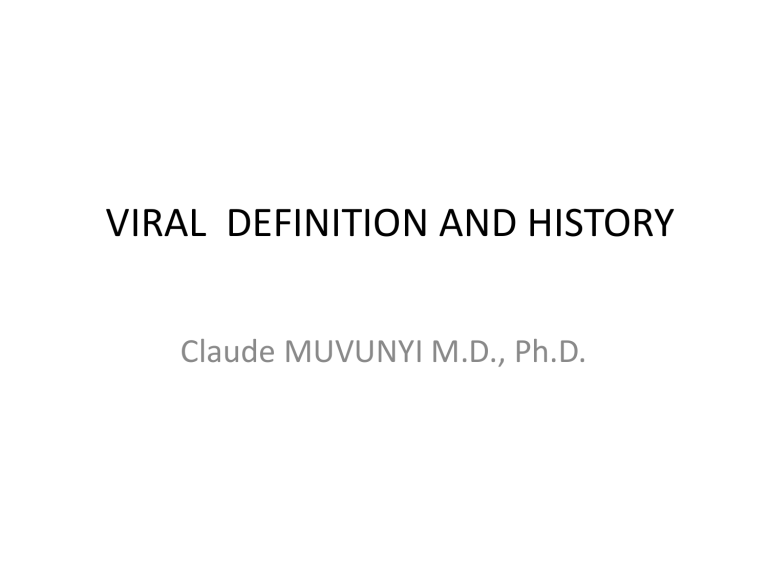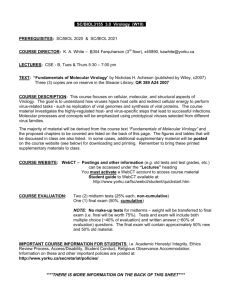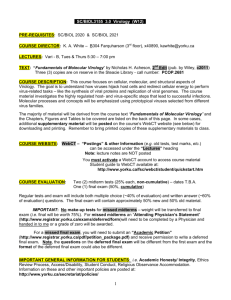Lecture 1_ VIRAL DEFINITION AND HISTORY
advertisement

VIRAL DEFINITION AND HISTORY Claude MUVUNYI M.D., Ph.D. What are viruses ? Viruses are distinct from living organisms. The simplest definition of viruses is • Submicroscopic • Obligate intracellular parasites What are viruses ? Viruses are smaller than bacteria, they range in size between 20-300 nanometer ( nm ). Viruses contain only one type of nucleic acid, either DNA or RNA, but never both. Viruses consist of nucleic acid surrounded by a protein coat. Some viruses have additional lipoprotein envelope. Viruses lack cellular organelles, such as mitochondria and ribosomes. What are viruses ? Viruses are obligate cellular parasites. They replicate only inside living cells. Viruses replicate through replication of their nucleic acid and synthesis of the viral protein. Viruses do not multiply in chemically defined media. Viruses do not undergo binary fission. Viruses are absolutely dependent on the host cell for their function What are viruses ? Definition of a Virus Sub microscopic entity consisting of a single nucleic acid surrounded by a protein coat and capable of replication only within the living cells of bacteria, animals or plants. Are viruses alive or not ? Are viruses alive or not ? • Inside the host cell, viruses are alive • Outside, viruses are merely complex assemblages of metabolically inert chemicals Virus-related entities Viroid • are very small (200-400 bases) circular RNA molecules with a rod-like secondary structure • They have no capsid or envelope and are associated with certain plant diseases • Their replication strategy is like that of viruses --> they are obligate intracellular parasites Virus-related entities Virusoids • Are satellite, viroid-like molecules somewhat larger than viroids (approximately 1000 nucleotides) • Are dependent on the presence of virus replication for multiplication • They are packaged into virus capsids as passengers Virus-related entities Prions • Are infectious agents consisting of a single type of protein molecule • The prion protein and the gene encoding it are also found in normal 'uninfected' cells • These agents are associated with Creutzfeldt-Jakob disease and kuru disease in humans, scrapie in sheep and bovine spongiform encephalopathy (BSE) in cattle History of Virology History of Virology In 3700BC: • 1st written record of a virus infection consists of a heiroglyph from ancient Egypt, • Typical clinical signs of paralytic poliomyelitis. History of Virology In 1196BC: Pharaoh Ramses V, who died, is believed to have succumbed to smallpox - compare the pustular lesions on the face of the mummy & those of more recent patients. History of Virology In 1000BC: Smallpox was endemic in China . • In response, the practice of variolation was developed. • Recognizing that survivors of smallpox outbreaks were protected from subsequent infection, • variolation involved inhalation of the dried crusts from smallpox lesions like snuff History of Virology On 14th May 1796: Edward Jenner used cowpox-infected material obtained from the hand of Sarah Nemes, a milkmaid from his home village of Berkley in Gloucestershire to successfully vaccinate 8 year old James Phipps. On 1st July 1796, Jenner challenged the boy by deliberately inoculating him with material from a real case of smallpox ! He did not become infected !!! History of Virology History of Virology However, it was not until Robert Koch & Louis Pasteur jointly proposed the 'germ theory' of disease in the 1880s that the significance of these organisms became apparent. Robert Koch (1843-1910) Louis Pasteur (1822-1895) Koch defined the four famous criteria now known as Koch's postulates which are still generally regarded as the proof that an infectious agent is responsible for a specific disease: Koch's postulates i. The agent must be present in every case of the disease. ii. The agent must be isolated from the host & grown in vitro. iii. The disease must be reproduced when a pure culture of the agent is inoculated into a healthy susceptible host. iv. The same agent must be recovered once again from the experimentally infected host. History of Virology In 1885: Louis Pasteur Subsequently, worked extensively on rabies, which he identified as being caused by a 'virus' (from the Latin for 'poison') in spite of this, he did not discriminate between bacterial & other agents of disease. History of Virology In 1892: Dmiti Iwanowski (1864-1920) described the first "filterable" infectious agent - tobacco mosaic virus (TMV) - smaller than any known bacteria. Iwanowski was the first person to discriminate between viruses and other infectious agents, although he was not fully aware of the significance of this finding. This is generally recognized as the beginning of Virology History of Virology In 1898: Martinus Beijerinick (1851-1931) extended Iwanowski's work with TMV and formed the first clear concept of the virus "contagium vivum fluidum" - soluble living germ. Beijerinick confirmed and extended Iwanowski's work and was the person who developed the concept of the virus as a distinct entity. History of Virology Also in 1898: Freidrich Loeffler (1852-1915) and Paul Frosch (18601928) demonstrated that foot and mouth disease is caused by such "filterable" agents. Loeffler and Frosch were the first to prove that viruses could infect animals as well as plants. History of Virology In 1900: Walter Reed (1851-1902) confirmed that yellow fever is spread by mosquitoes. Although Reed did not dwell on the nature of the yellow fever agent, he and his coworkers were the first to show that viruses could be spread by insect vectors such as mosquitoes. Dr. Carlos Finlay (Cuba) did the discovery of the yellow fever vector. Walter Reed (1851-1902) History of Virology In 1908: Karl Landsteiner (1868-1943) and Erwin Popper proved that poliomyelitis was caused by a virus. Landsteiner and Popper were the first to prove that viruses could infect humans as well as animals. Karl Landsteiner 1868 – 1943 (Nobel Prize, 1930). History of Virology In 1911: Francis Peyton Rous (1879-1970) demonstrated that a virus (Rous sarcoma virus) can cause cancer in chickens Rous was the first person to show that a virus could cause cancer. Francis Peyton Rous (1879-1970) (Nobel Prize, 1966). History of Virology In 1915: Frederick Twort (1877-1950) discovered viruses infecting bacteria. In 1917: Felix d'Herelle (1873-1949) independently discovered viruses of bacteria and coins the term bacteriophage. The discovery of bacteriophages provided an invaluable opportunity to study virus replication at a time prior to the development of tissue culture when the only way to study viruses was by infecting whole organisms. Frederick Twort (1877-1950) Felix d'Herelle (1873-1949) History of Virology In 1933: Isolation of human influenza virus • Transfer from animals to humans 6000 years ago • Pandemics 1918 (Spanish flu, H1N1), 1957 (Asian, H2N2), 1968 (Hong Kong, H1N2), 2009 (Mexican, H1N1). • Influenza A virus infects chicken embryos • Production of virus • Production of influenza vaccines History of Virology In 1938: Max Theiler (1899-1972) developed a liveattenuated vaccine against yellow fever • Theiler's vaccine was so safe and effective that it is still in use today! • This work saved millions of lives and set the model for the production of many subsequent vaccines. (Nobel Prize, 1951). History of Virology In 1939: Emory Ellis (1906-) and Max Delbruck (1906-1981) established the concept of the "one step virus growth cycle" essential to the understanding of virus replication (Nobel Prize, 1969). This work laid the basis for the understanding of virus replication - that virus particles do not "grow" but are instead assembled from preformed components. History of Virology In 1940: Helmuth Ruska (1908-1973) used an electron microscope to take the first pictures of virus particles. Along with other physical studies of viruses, direct visualization of virions was an important advance in understanding virus structure. History of Virology In 1949: John Enders (1897-1985), Thomas Weller (1915-) and Frederick Robbins (1916-) were able to grow poliovirus in vitro using human tissue culture (Nobel Prize, 1954). This development led to the isolation of many new viruses in tissue culture. John Enders (1897-1985), History of Virology In 1957: Carleton Gajdusek proposes that a "slow virus" is responsible for the prion disease kuru (Nobel Prize, 1976). Gajdusek showed that the course of the kuru is similar to that of scrapie, that kuru can be transmitted to chimpanzees and that the agent responsible is an atypical virus. History of Virology In 1963: Baruch Blumberg discovered hepatitis B virus (HBV) (Nobel Prize, 1976). Blumberg went on to develop the first vaccine against the HBV, considered by some to be the first vaccine against cancer because of the strong association of hepatitis B with liver cancer. Baruch Blumberg (1925 – 2011) History of Virology In 1967: Theodor Diener discovered viroids, agents of plant disease which have no protein capsid. Viroids are infectious agent consisting of a low molecular weight RNA that contains no protein capsid responsible for many plant diseases. History of Virology In 1970: Howard Temin (1934-1994) and David Baltimore independently discovered reverse transcriptase in retroviruses (Nobel Prize, 1975). The discovery of reverse transcription established a pathway for genetic information flow from RNA to DNA, refuting the so-call "central dogma“ of molecular biology. History of Virology In 1977: Richard Roberts, and independently Phillip Sharp, show that adenovirus genes are interspersed with non-coding segments that do not specify protein structure (introns) (Nobel Prize, 1993). The discovery of gene splicing in adenovirus was subsequently found to apply to cellular genes – a fundamental principle. History of Virology In 1979: Smallpox was officially declared to be eradicated by the World Health Organization (WHO). The last naturally occurring case of smallpox was seen in Somalia in 1977. This was the first microbial disease ever to be completely eliminated. History of Virology In 1981: Yorio Hinuma and colleagues isolated human T-cell leukaemia virus (HTLV) from the patients with adult T-cell leukaemia. Although several viruses are associated with human tumours, HTLV was the first unequivocal human cancer virus to be identified. History of Virology In 1982: Stanley Prusiner demonstrates that prions are infectious proteins. Prions cause scrapie, a fatal neurodegenerative disease of sheep (Nobel Prize, 1997). This was the most significant advance in understanding of what were previously called "slow virus" diseases and are now known as transmissible spongiform encepthalopathies (TSEs). History of Virology In 1983: Luc Montaigner (Nobel prize, 2008) and Robert Gallo announced the discovery of human immunodeficiency virus (HIV), the causative agent of AIDS. In only 2-3 years since the start of the AIDS epidemic the agent responsible was identified. History of Virology In 1989: Hepatitis C virus (HCV), the source of most cases of nonA, nonB hepatitis, was definitively identified. This was the first infectious agent to be identified by molecular cloning of the genome rather than by more traditional techniques (see 1994).






